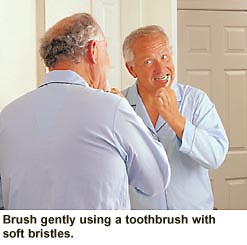Treating Sensitive Teeth
Treating Sensitive Teeth
See your dentist if you have sensitive, painful teeth. Your dentist will examine your teeth to find the cause of your tooth sensitivity. Then he or she will advise a treatment plan.

Your dental exam
Your dentist will check your teeth for sensitivity to cold, air, or heat. Let him or her know if you have foods or drinks that are high in acid, such as citrus fruits or sports drinks. Also tell your dentist about any stomach problems you may have that bring acid into your mouth. Your dentist will also look inside your mouth to check for decayed teeth, or teeth worn by incorrect brushing. If needed, X-rays will be taken. You may also be checked for signs of teeth grinding, or clenching. You may start out with a special oral hygiene program for home care. In addition to home care your dentist may also suggest professional treatment.

Home care
Your dentist may suggest that you follow an oral hygiene program at home. Use a toothbrush with soft bristles. If any roots are exposed, you may be asked to use a special toothpaste. This toothpaste makes teeth less sensitive. Your dentist may also suggest that you try a fluoride rinse or gel, or a desensitizing toothpaste. Cleaning all parts of your teeth and mouth helps prevent tooth sensitivity and decay.
Professional treatment
Depending on how sensitive your teeth are, your dentist may suggest professional treatment. He or she may:
-
Apply special chemicals to the sensitive areas.
-
Use a coating of resin to seal the dentin.
-
Fill cavities or deep grooves in any exposed root.
-
Apply a fluoride varnish to the root surface.
Know that your teeth can become sensitive again. Be sure to follow your home-care treatment plan. Also schedule regular dental exams. By working with your dentist, you can help keep your teeth pain-free.
Updated:
February 27, 2020
Sources:
Dentin hypersensitivity: Recent trends in management, Miglani, S. Journal of Conservative Dentistry. 2010, is. 13, ed. 4, pp. 218-24.
Reviewed By:
Michael Kapner MD,Rita Sather RN,Cynthia Godsey